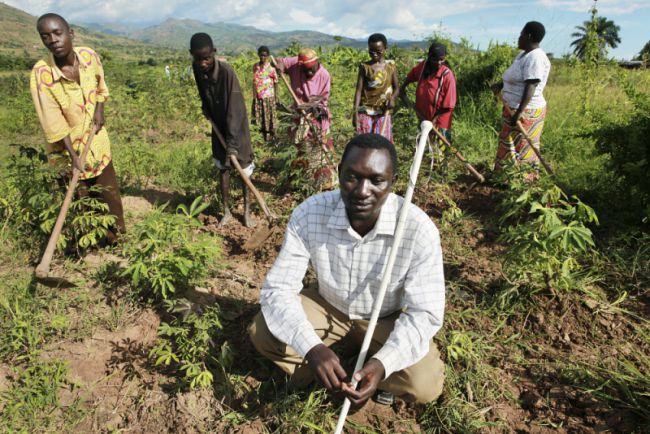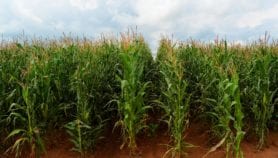By: James Kinyangi
Send to a friend
The details you provide on this page will not be used to send unsolicited email, and will not be sold to a 3rd party. See privacy policy.
Agriculture should be integral to global dialogue on climate change, writes James Kinyangi.
As ocean temperatures rise and trade winds slacken across the Pacific, scientists have confirmed the arrival of El Niño, a climate system known for fanning typhoons in the Central Pacific and for initiating droughts in southern Africa and other regions of the world.
This year’s El Niño promises to be a strong one, as it has already helped fuel three hurricanes in the eastern Pacific Ocean. And in Sub-Saharan Africa, where there have been small but definite improvements in food security from 1994 to 2014, [1] the news of El Niño could not be worse, as it could bring weather extremes — drought and flooding — to many vulnerable areas.
Chad, Mali, Niger and Nigeria are especially vulnerable to drought.
“In Africa, climate change is expected to lower crop yields by at least five per cent with two degrees Celsius warming, and by about 15 per cent should warming increase to 2.5 degrees Celsius.”
James Kinyangi, CGIAR Research Program on Climate Change, Agriculture and Food Security
Countries in southern Africa may experience below normal rainfall, and in East Africa we’ve seen flooding in Malawi and parts of Tanzania.
Climate change and agriculture
El Niño is bound to compound the challenges already posed by climate change, including less rain, higher temperatures, and the spread of diseases and pests across large food-growing areas. Furthermore, research has shown that in a warming world, the frequency of strong “super” El Niños is expected to double. [2]
The impact of climate extremes, whether in the form of a super El Niño or other long-term trends, hits those worried about the region’s agriculture and food security right in the gut.
In Africa, climate change is expected to lower crop yields by at least five per cent with two degrees Celsius warming, and by about 15 per cent should warming increase to 2.5 degrees Celsius. [3] Such yield decreases could have dramatic impacts on both food prices and food security.
Climate change is already expanding the range of pests and pathogens that infect livestock, fish and crops. For example, maize lethal necrosis disease, against which there is no known resistance, and coconut lethal yellowing disease, which has devastated coconut production in Mozambique and moved north into Kenya and Tanzania, are a nuisance.
Meanwhile, epizootic ulcerative syndrome, a climate-sensitive fish disease, is spreading along the length of the Zambezi River, Africa’s fourth longest.
Climate pact: agriculture missing
But despite the obvious impacts of climate change on agriculture — in Africa and elsewhere — the new global climate change deal now being developed makes scant mention of agriculture. The omission has been glaring, and adaptation isn’t the only concern when it comes to climate change. Agriculture and its associated land uses contribute about one quarter of the world’s greenhouse gas emissions, offering major opportunities to mitigate climate change.
“As the world looks ahead to the Paris negotiations in December, the international dialogue needs to make agriculture integral to all agreements and activities.”
James Kinyangi, CGIAR Research Program on Climate Change, Agriculture and Food Security
The draft climate change pact will be the basis for what could be adopted at the Paris climate summit in December this year. There is actually very little time left to modify the accord so that among other things, it ensures developing countries get the assistance they need to reduce emissions and adapt to changing growing conditions.
One of the primary opportunities for changing direction was a series of meetings in Bonn, Germany, that concluded in June. [4] After being mostly overlooked for the last ten years, agriculture was on the agenda of the Subsidiary Body for Scientific and Technical Advice, and delegates learned of the impacts climate change will have on agriculture, including increased risk of pest and disease outbreaks.
They also learned about the urgent need for “early warning systems” to give farmers advanced notice of major threats, such as an impending El Niño, and discussed the overall vulnerability of different food-growing regions to climate change.
Strong early warning systems for impending extreme weather conditions give governments and farm communities time to prepare, and there is lot of work underway to make them more precise and to provide longer lead times.
The strengthening of these early warning systems, particularly their ability to reach the right audiences with the necessary information, should be a central feature of Africa’s adaptation agenda, and supported by the next global climate convention.
Africa's economy grew at an annual average of 5.2 per cent from 2003 to 2012. [5] Agriculture helped drive this growth, with annual agricultural GDP averaging 5 percent over a ten-year period since 2003. The African Development Bank reports that 230,000 kilometres of feeder roads were constructed or repaired between 2010 and 2014. [6]
This means improved transport for more than half a million people. It also brought farmers closer to markets, and reduced food spoilage. Over the same time, almost one million hectares of land were replanted or reforested, helping to boost the overall soil fertility.
Paying attention to agriculture
Agriculture is front and centre of national and regional economic development strategies in Africa. Governments recognise agriculture as an engine of economic growth, as it accounts for 60 per cent of employment and is uniquely capable of reducing poverty and increasing incomes across all economic classes. [7]
As the world looks ahead to the Paris negotiations in December, the international dialogue needs to make agriculture integral to all agreements and activities. No matter which way the political winds blow, farmers will tell you that the weather is getting stormier.
James Kinyangi is the East Africa program leader for the CGIAR Research Program on Climate Change, Agriculture and Food Security (CCAFS). He holds PhD (Cornell University) and MSc (Michigan State University) degrees in Crop and Soil Sciences. He can be reached at [email protected]
This article has been produced by SciDev.Net's Sub-Saharan Africa desk.
References
[1] FAO, IFAD and WFP The state of food insecurity in the world. Strengthening the enabling environment for food security and nutrition (FAO, 2014).
[2] Wenju Cai and others Increasing frequency of extreme El Niño events due to greenhouse warming (Nature Climate Change, 14 January 2014)
[3] The Potsdam Institute for Climate Impact Research and Climate Analytics Turn down the heat: climate extremes, regional impacts, and the case for resilience (World Bank, 2013)
[4] United Nations Framework Convention on Climate Change (UNFCC), Bonn climate change conference – June 2015 (UNFCC, June 2015)
[5] Alliance for a Green Revolution in Africa (AGRA) Transforming Africa’s agriculture for sustainable inclusive growth, improved livelihoods and shared prosperity (AGRA, July 2015)
[6] African Development Bank (AfDB), Interview with Chiji Ojukwu, director, Agriculture and Agro-Industry Department, AfDB (AfDB, 22 May 2015)
[7] African Development Bank, the Organisation for Economic Cooperation and Development and the United Nations Development Programme Africa economic outlook report: Structural transformation and natural resources (AfDB, OECD and UNEP, 2013)














